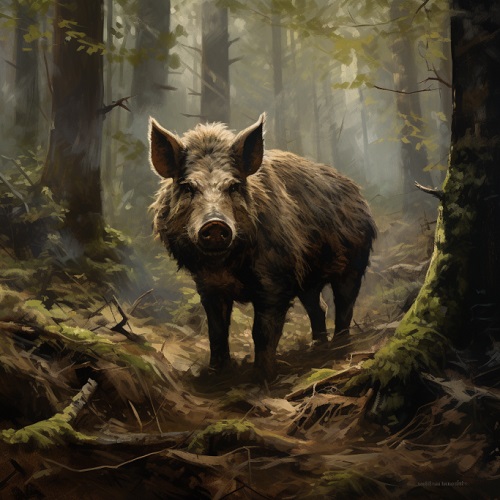The Hot Boars of Germany
Dear Dr. Z, I saw something in my news feed about wild boars in Germany having too much radioactivity in them, but I don’t really know how big a deal this is. I’m invited to a wild game dinner next month – should I cancel?
https://www.nytimes.com/2023/09/02/world/europe/germany-boars-radioactivity-study.html
This is actually pretty cool stuff! I love a story like this – one that’s based in science, and in which the science tells us something unexpected, but that makes sense when we give it some thought. We’re likely to keep learning more about this as time goes on – but here’s what’s happening as far as I can tell now. And we’ll start with the Chernobyl nuclear reactor accident.
You might recall that the Chernobyl accident released a lot of radioactivity into the environment, including volatile elements such as iodine and cesium. These elements drifted with the wind, blanketing much of Europe with contamination, including two radioactive isotope of cesium – Cs-135 and Cs-137. Because cesium is chemically similar to potassium, living organisms can take it into their tissues and the radioactivity can enter the food chain to be eaten by people, exposing them to elevated levels of radiation. For this reason, governmental health and environmental agencies across Europe have been sampling soil, water, plants, and animals across the contaminated areas since the 1986 accident.
The primary aim of this sampling is to find out if the radioactivity poses a risk to people living in these area; the expectation has been that we should see the amount of radioactivity dropping over time as the radioactive cesium decays away – with a half-life of just over 30 years, we’d expect to see only half as much of this in the environment today compared to what was present in 1993 (with a 2.3 million-year half-life, Cs-135 hasn’t decayed appreciably, but there was far less of this nuclide produced in the accident). So it’s been a bit of a surprise to realize that the amount of Cs-137 in wild boar meet hasn’t been dropping as much as expected – not exactly what one would expect based on the physics of radioactive decay. Since our understanding of the physics is pretty solid, it seemed likely that there was a different source of Cs-137 that the boars were exposed to.
What helped researchers unravel this problem was the Cs-135. Or, more precisely, the ratio of the two cesium isotopes.
When a uranium atom fissions it splits into two radioactive fission products; one of those fission products usually weighs about 130 to 140 atomic mass units and the other weighs somewhere in the vicinity of 90-100 atomic mass units. By comparing the amount of Cs-135 to the amount of Cs-137 scientists can estimate how long ago the radioactivity they’ve found was produced.
Let’s take an easy example – we’ll assume that at the time the radioactive cesium entered the environment there were equal amounts of Cs-135 and Cs-137. After 30 years half of the Cs-137 will have decayed away, but virtually all of the much longer-lived Cs-135 will still be in the environment. To put some numbers to it:
- if one gram of soil initially contained 100 atoms each of Cs-135 and Cs-137 then the ratio of these nuclides is 100 Cs-135 atoms / 100 Cs-137 atoms, which is a ratio of 100/100; this is equal to 1.
- After 30 years we still have 100 atoms of Cs-135 but we’re down to only 50 atoms of Cs-137; 100/50 = 2.
- After 60 years (two half-lives of Cs-137) we still have 100 atoms of Cs-135 but we’re down to only 25 Cs-137 atoms; 100/25 = 4 so the ratio is now equal to 4.
So, say we take a sample of wild boar meat and measure a little more than twice as much Cs-135 as we do Cs-137. What this tells us is that half of the Cs-137 has decayed away; that the cesium in the meat was deposited a little more than 30 years ago; close to the time of the Chernobyl accident. So in this example, a Cs-135 : Cs-137 ratio of 2:1 would most likely represent radioactivity that was released into the environment by the Chernobyl accident. But what they found in the German wild boar meat was higher than expected; the ratio they found told them that much of the cesium was produced about 60 years ago and most likely came from atmospheric nuclear weapons testing that took place in the 1940s, 1950s, and 1960s, and that collected in truffles that the boar dig up and eat.
So that’s where the cesium came from – now let’s figure out if you need to change your dinner plans.
The place to start is with the European regulatory limit for radioactivity in food – 600 Becquerels (Bq) of Cs-137 per kg. If you eat 1 kg (2.2 pounds) of wild boar meat that is right at the regulatory limit then you’ll have ingested 600 Bq of Cs-137, which will expose you to less radiation than you’d receive from 5 minutes’ exposure to natural radiation, and far less than you’d receive from flying from, say, Cleveland to Detroit. So even if you were to be fed wild boar that managed to slip by the regulatory agencies with 10 times as much radioactive cesium as what’s permitted by regulations your radiation exposure will still be too low to cause any risks to your health. Which means you don’t need to change your dinner plans!
